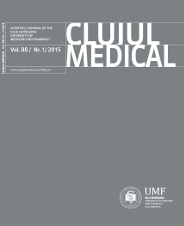Subantral augmentation with a 1/1 alloplastic and autologous material mixture. Histological characteristics and dimensional stability of the newly formed bone
DOI:
https://doi.org/10.15386/cjmed-400Keywords:
sinus lift, alloplastic graft, autologous graft, bone substitute,Abstract
Background and aim. The maxillary sinus augmentation procedure is the most frequent method used to prepare the posterior maxillary area, with bone deficit, for the placement of dental implants. For this purpose, several types of materials have been used as bone grafts, each of these materials having a number of advantages and disadvantages. The present study is aimed at evaluating the histological and volumetric properties of an alloplastic and autologous material mixture.
Patients and methods. The study included 7 selected patients who underwent subantral bone augmentation with a 1/1 autologous and alloplastic material mixture. Subsequently, at the time of dental implant placement, biological samples were taken from the bone augmentation area and were histologically analyzed. The subantral bone resorption rate was also evaluated in parallel.
Results. Histological examination evidenced the presence of residual amorphous material in the bone augmentation area. The mean bone resorption rate was 15.15%. The presence of a high bone resorption rate was correlated with the presence of a smaller residual amorphous material amount in the subantral bone augmentation area.
Conclusions. The association of autologous and alloplastic material for subantral bone augmentation improves the characteristics of the two material types.
Downloads
Additional Files
Published
How to Cite
Issue
Section
License
The authors are required to transfer the copyright of the published paper to the journal. This is done by agreeing to sign the Copyright Assignment Form. Whenever the case, authors are also required to send permissions to reproduce material (such as illustrations) from the copyright holder.

The papers published in the journal are licensed under a Creative Commons Attribution-NonCommercial-NoDerivatives 4.0 International License.

